~ 21 ~
~ The Study of Threes ~
http://threesology.org
Researchers as of 8/29/2019
| Devil's Advocate Series: | ||||||||
|---|---|---|---|---|---|---|---|---|
| 1 | 2 | 3 | 4 | 5 | 6 | 7 | 8 | 9 |
| 10 | 11 | 12 | 13 | 14A 14B |
15 | 16 | 17 | 18 |
| 19 | 20 | 21 | 22A 22B |
23 | 24 | 25 | 26 | 27 |
| 28 | 29 | 30 A | 30 B | 31 | 32 | 33a | 33b | 33c |
| 34 | 35 | 36 | 37 | 38 | 39 | 40 | 41 A | 41 B |
Subjectively, I think I am being objective in my Devil's Advocate role. Objectively, however, I realize I am still being subjective and that this realization does not provide me with an actual third position... though in reflection, the supposed subjectivity/objectivity consideration may in fact be little more than a front-to-back, or side-to-side, or top-to-bottom mirror-image (or house-of-mirrors) reflection of a singularity. Irrespective of all this philosophizing, I pursue the development of a timeline which is exposing patterns that involve an emphasis of pattern-of-three, though they may not be conveniently portrayed with an enumerated 1-2-3 identity. In some cases only a singularity need be shown and suggested as a possible 'to-become' (in the process of becoming) or 'once-was' (some tell-tale sign of existence or possible remnant of extinction) of a pattern-of-three.
Yet, let me emphasize that a pattern-of-three may well exercise an inherently designed (processional) inclination to exhibit a grouping that may appear to lack sequentiality, but in fact is part of a sequence that is difficult to illustrate or simply has not been thought of in these non-sequential terms. For example, sequentiality need not take place within a span of time in a single context. Action and reaction may well have causal connections that do not exhibit closeness in time and space relative to human perception. If we allow human perception to define every cause and effect, then the cause and effect themselves may not be seen as part of a larger sequentiality because human perceptions isolate them with ideas that they must occur in a given time and place that a single human perception can identify and that other singular human perceptions can agree upon because they occur within the common sphere of human perception.
In terms of commonly understood sequencing for example, a convention of easily understood seqentiality is the 123... counting scheme as well as the ABC letters expression... found in the English alphabet. And though there is a further convention of dividing up sets of three groupings of numbers (ones- tens-hundreds, thousands- ten thousands- hundred thousands, etc...) with a comma, there is no such visible point of demarcation for the letters of the alphabet, except in the regularity of expression which denotes that we teach a child their "ABCs", and do not customarily include a fourth (D), fifth (E), sixth (F) or other letters in the expression. Though the expression exhibits only one set-of-three letters, it nonetheless illustrates a similarity of cognitive orientation to group into three.
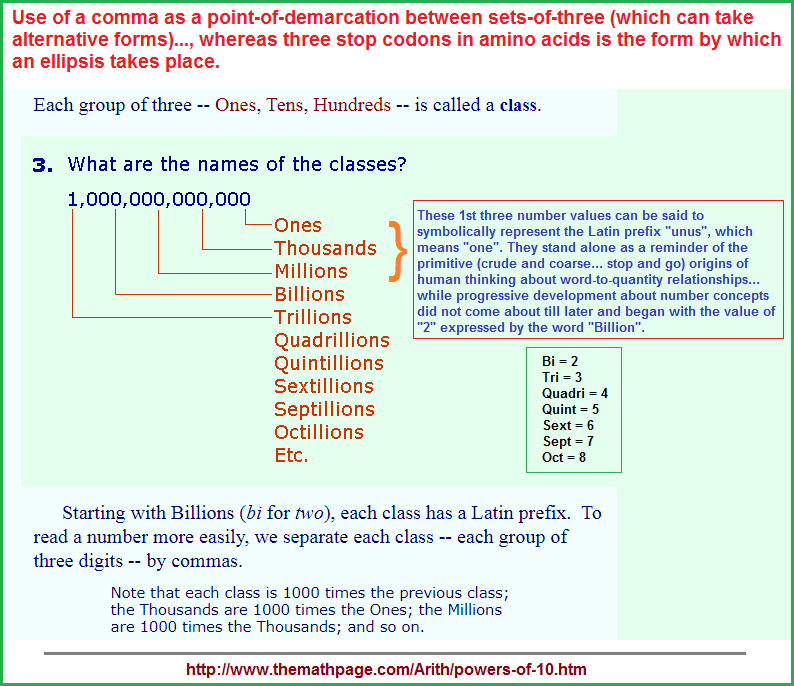
Although I have initially focused on providing examples of "threes" from a biological context aligned with an ongoing effort to create a timeline, I have found that with but a little imaginative exertion I can find biological correlations in many different examples of three-patterned illustrations from different subject areas. There always appear to be a way and means of making a correlation to some aspect of biology, since ideas come from the mind, the mind from the brain, the brain from the body and of course the body is tied to biology. Then again, a person with an interest in any fundamental exercise of nature such as harmonics, atomic particles, solids-liquids-gases... plasma, can also find correlations to their focus. The problem is not so much in someone making a connection, but finding or getting someone else to recognize the pattern as well. Then again to suggest what the pattern may represent and whether it is merely for philosophical speculation or can be applied in some manner of practicality in a given context in a given era.
Whereas there are many creatively minded individuals, not all of them are inclined to express their perceptions in a manner or time that can be shared with others. Lots of people are not interested in sharing their views. The prefer to hoard them and use them to their singular advantage, as if they have some unique insight by which they can secure some income. Many of them in fact search for some tell-tale sign that they can adopt to their efforts, such as we come across someone who has plagiarized the idea of another. This also occurs amongst so-called professionals who are not above stealing ideas from students or subordinates, and are in a position to either buy the person off or gain support from one or more others in either denouncing someone or relegating them to a position where their claims of theft are viewed as being suspect. On more than one occasion I have found one another of a person's ideas being used by others who they did not give credit to. This is why it is extremely important for anyone conducting research to be upfront about wanting to ensure that any and all of their revealed ideas or off-the-cuff notions... have no intention of plagiarizing anyone's work. Even if someone does not secure the permission to use a portion of another's work... or even use an entire transcript... a deliberate effort needs to be made to show that the author or author's are being credited and their work is not being used for purposes other than intended by them... such as in an educationally-directed expose'.
Granted two or more people may come up with similar ideas and even undertake similar experiments or constructive designs, this is highly different than someone deliberately trying to conceal they have confiscated another's view(s) and attempted to make it appear as if it were their own by making some changes in one or another aspect. So let me state again, I have no desire to plagiarize anyone's ideas. I will make an attempt to provide credit where credit is due, though the credit given may be misplaced because the source has yet another source that was not listed. While it is understandable that some people get distracted and forget to mention a source, others do this deliberately to try to give the impression they have provided an original idea. They think that by finding something in some obscure text or corner of some overlooked pedestrian nook and cranny of observation, they will not be found out. But they eventually will... unless they scheme by way of a great effort to obscure all trails to and from their source and any mention of the source from any avenue of communication which may occur. They are criminally minded and criminal minds do occur among so-called professionals. There is little need for me to provide examples of the Jekyll and Hyde dichotomous nature of businesses, governments, religions, sciences, arts, sports, entertainment industry, etc.. To take but one example, though we can identify the U.S. as being generous, compassionate, honest, trustworthy, dutiful, sincere, empathetic, and filled with every virtue we think to find in the best of every person, the flip side of the coin is to note that it has regularly also shown itself to be one of the most back-stabbing, double-dealing, two-faced (dichotomously acting) criminal organizations ever constructed... (despite the falsification of its three divisions: Executive-Legislative-Judicial)— but not the worst nor the only one in existence today.
And yet, with such a dichotomous nature, this overall example does not routinely become aligned with the larger cognitive patterning found amongst humans within the U.S. culture(s), outside the culture in other cultures and in the context of humanity throughout its history and the history of its development as but another type of species exhibiting recurring patterns. Even though the patterns we find in biology, physics, and other sciences which look outside the parameters of human existence are patterns created by the perceptions of humans, we need to record them in an effort to establish where, when and how such patterns occurred... and if the are indeed a product of that being studied or are little more than a projection of human cognition... in a type of cognitive anthropomorphism. In other words, are the patterns being recognized in non-human biological contexts little more than projections of patterns practiced by humans, whether the observer is aware of this or not?
Let us take for example the described three flavors of neutrinos aligned to mass states (to change the tempo and orientation of the foregoing):

Do three mass states actually exist, or is this pattern little more than a projection of an unrecognized mindset pattern dominating physicists? Indeed, let us take a gander at some associated particle physics patterns as well, previously shown on page 11 of this series:
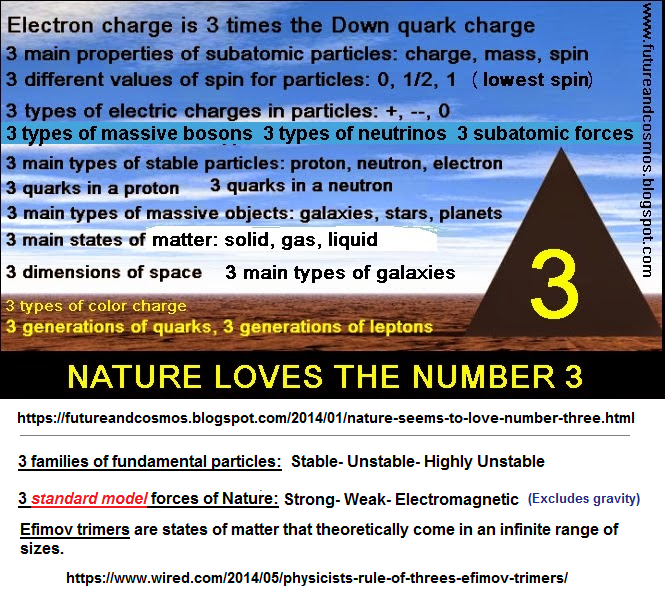
Do all these patterns-of-three actually exist in particle physics, or are they simply a recurring figment of a similarly oriented pattern-of-three orientation? And if we find one or more physicists focusing on some other pattern as well, might we find that they are simply involving three different types of pattern recognition without being aware of such... and are therefore exercising yet another model of a pattern-of-three thinking?
No less, in looking at a picture of our solar system which describes our place of residence as that on the 3rd planet, we must ask if we are actually on the 3rd planet or is our human mind merely complying with an unrecognized brain schema corresponding to that we can presently describe as a pattern-of-three, but may be a pattern or some other characteristic which the primivity of our present state of evolution can not yet grasp? Then again, the present arrangement of these objects called planets may not be as it was billions of years ago, whereby the Earth was not number 3.

While some might argue that the patterns exist within the objects being studied, we can find examples that may appear to be correct identifications, but are in fact arbitrarily designated depending on one's person opinion. For example, if we begin narrowing our focus of the Earth to large geographical areas seen from space, we might be inclined towards the number 7 and use a seven continent model, or a 6 continent model, or a 5 continent model, or a 4 continent model:
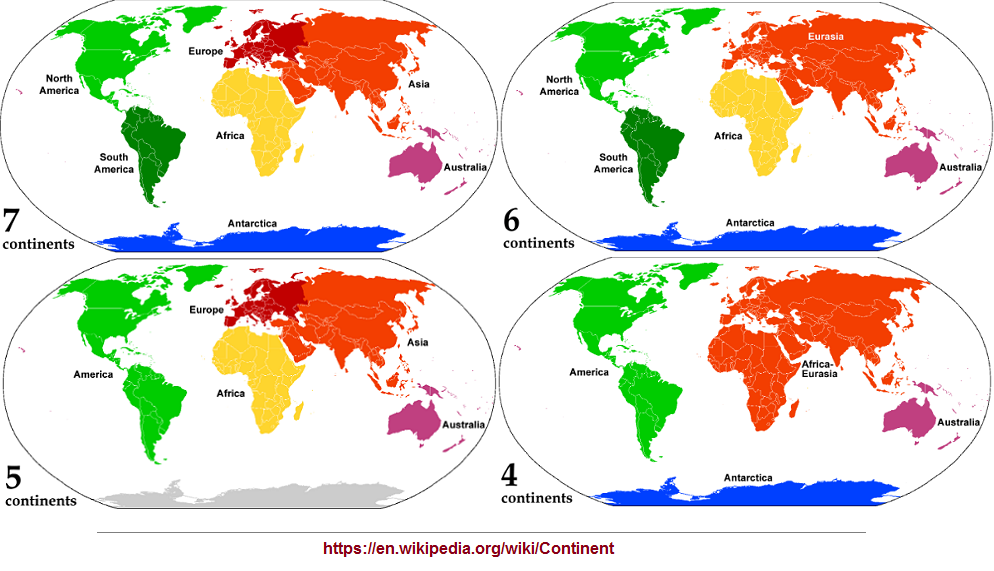
Yet, if so desired, we can view the continents with a 3, or 2 or even 1-patterned mindset, and supply all the needed arguments that further sway us... and perhaps others, towards agreeing with one or another patterned orientation:
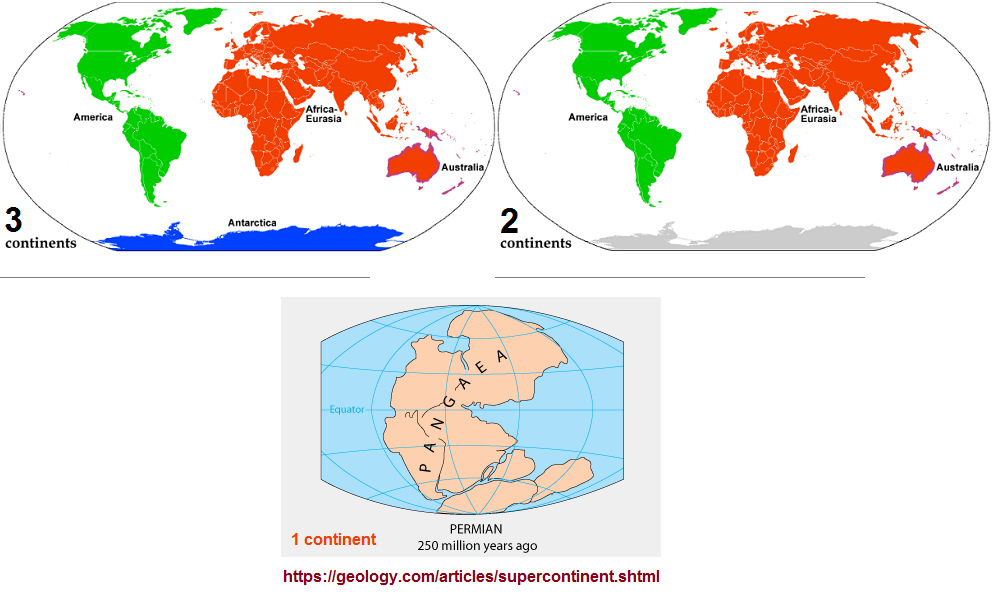
Just as in the case of the number of particles and sub-particles we (think we) find today, so is it true for the quantity of continents. Yet in attempting to describe the presence, do we use a word such as evolution? Did the atomic particles of today arrive by way of Evolution, or devolution... or neither? The same question can be posed for the continents as well. If we say there are several pieces of a single continent, where then did the single continent break off from? And why only one initial piece? Likewise with particles. Are they but pieces— but fragments of a once larger whole? However, one might think that such questions lead us astray from pondering why their appears to be a dominant recurrence of only a few patterns such as a pattern-of-three, or a pattern-of-two, or a singularity, etc...
If we apply this same type of thinking to cells, can we say that organelles are bits and pieces of a once singular whole? Not necessarily the same whole, but some whole that is no longer existing? No less, why is there a limitation as to the type and quantity of organelles and functionality thereof, as if to express an exclusive inclusiveness, like some aristocratic boys or gentleman's club? The same thing for the types and quantities of sub-atomic particles. Are they subjected to unrecognized positioning like the continents which helps or hinders that which can be a part of the environment? Such that, if we recognize the encroachments of sand and surf on continents, is something similar taking place in the realms of cells and atomic particles? Are there climatic changes taking place that we are unaware of because we did not think to consider, much less look for because our methodologies of measurement are too primitive?
In attempting to ascertain whether or not the patterns we are describing (1s,2s,3s, geometric, color, sound,) from one or more senses is real or a projection of some underlying schema pre-built in the mind due to some recurrence of the pattern occurring in biological substrates (or even atomic nuclei) which act to influence later mental paradigms, is a consideration which falls onto the realm of consideration dealing with the scope of inquiry found in the philosophical concept Wikipedia: The argument from illusion dealing with Stanford Encyclopedia Of Philosophy: sense data by Michael Huemer, or references to former ideas such as The “Argument from Illusion” and the Cartesian Philosophy of Ideas by Kim Sang Ong-Van-Cung; yet none of the online references I surveyed in a short cursory review of examples deals directly with the present discussion of whether or not the patterns we describe are the patterns which actually exist in the objects thought to be perceived— or are they references to some already internalized proclivity to hold a world-view in a given pattern. The articles which I quickly surveyed either deal with generalities, variously interpretable historical references to previous arguments about specific arguments of generality, or provide examples that are personalized exclusionaries directed towards a presumed all-encompassing generality... instead of any actual specificity like a directed experimental effort that can be tested by others ... as most philosophical treatises are anyway. Then again, despite the notable efforts of the three listed examples, how do we test a philosophical generality if it is always positioned so as to be able to retreat to some sanctuary, like so many politicians advancing a perspective which guarantees them a means to be excused from any fault and still receive a pension when all the dust clears from any commotion?
Philosophers do not customarily want their views subjected to any testable formula. Just like politicians who can excuse themselves from any campaign promise by claiming "the system" prevented them from making any headway in their efforts to keep their promises. Hence, most of what they say is hollow. It is an illusion or a delusion or a fairytale, myth, or specialized urban legend, where the "urbanity" is the name of many different streets in a city of philosophy, political science, politicians, religion hawkers and peddlers, and city corner doomsday or golden-future (manna from heaven) sooth-sayers.
Unlike most of philosophy, I am trying to create a means by which we can test at least one aspect of the "threes phenomena" occurrence. By listing them in reference to an organized timeline in the realm of developmental biology, we may be able to eventually show that it is a true "law of occurrence" exceeding present day observations, or whether it is an orientation coincident with the present era of scientific inquiry. Will it be sustained over time, or will perceptions change not only in biology, but physics as well? With the current models-of-three be replaced with other numerically identifiable models? Will this mean that the human mind has changed, we have better testing and analytical methods, or that we are witnessing a change in that which is being studied? If we tend to see different patterns, is this because our perceptions have been altered by some evolutionary change in the human brain, or that the item being studied has begun to evolve?
Let us look at the preliminary timeline again and add to it the human notion of a single god entity with three aspects known as Omniscience, Omnipresence, Omnipotent... though other traits are sometimes added such as all loving and all wise, but lacking in some respects that, when pointed out, are refuted by those who make excuses for the failing just as they make excuses for the failings of themselves and others they are protective of. Let me also add the three-part references of Father- Son- Holy Spirit, Brahma- Vishnu- Shiva, Virgin- Mother- Crone, and Young soul- Old soul- Ancient soul to the lineup of examples.
However, despite this 3-part "Omni-" grouping and other three-patterned arrays occurring in religion and so-called pagan worldviews, and despite the fact that these particular patterns-of-three deal with the developmental growth of the human brain in that humanity's concept of a singular god-like creature arose as a symbiosis or synthesis of multiple events being perceived by various primitive minds which frightened them (i.e., weather phenomena: wind, rain, fire, lightning explosions; geophysical planetary activity: darkness, cold, earthquakes; physical trauma: pain, sickness, injury, etc...); we can use it (and multiple other three-patterned references often tied to some duality and singularity) as an example of an enumerated pattern to be cataloged with other ideas that are focused specifically on biological events; irrespective if they are egotistically associated with the 'self' and its desire for a personalized reference in time and space which creates a directional (front/back... right/left... up/down) coordinate system of self-referencing from which may come delineated patterns-of-four idealisms.
In other words, the underlying patterns of activity (below the words and cultural applications that the words are used in a given context); when subjected to enumeration not tied to cultural or religious affections for any given number valuation (such as the number 7 in Judaism or 3 in Christianity, or 2 in the Yin/Yang of Eastern philosophy, etc...); might be useful for an overall evaluation as the information on the timeline develops further... though the totality of philosophical concepts arrayed in a number scheme would need their own timeline to be more fully addressed as to their singular origins progressing into dualities, from which triplicities have emerged... and not necessarily in a sequential order nor without variations or mutations which need to be unraveled just as the characteristics of different species need to be subjected to various types of comparative modeling. Numerical patterns can be viewed as species that need to be analyzed just as we would any biological or non-biological entity in our search for relationships, divergences from a single source, extinctions, rebirth, variation, external/internal variations, etc...
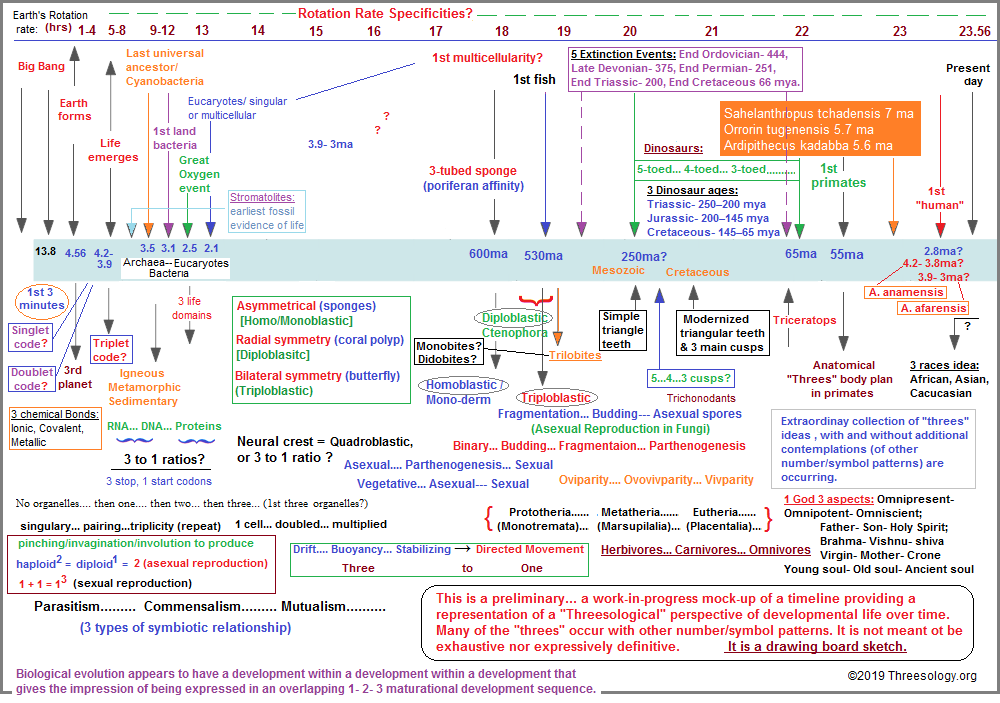
No doubt some of the examples may be found to be generalities which can be viewed with two or more alternative patterns, leading us to the consideration that we are dealing with multiple vagaries of perception. This of course harkens back to the perspective of Frances Bacon in his first book of the Novum Organum in which he invented the metaphor of "idol" to reference causes of human error. Whereas commentary directed towards a discussion of these idols routinely describe them as a quantity of four, I shall use a three-to-one ratio with descriptive information culled from the Britannica, because at the moment of this writing some 116 miles from Roswell, New Mexico at a rest stop where tethered internet service is lacking, I am viewing a description from this source: "Bacon, Francis, Viscount Saint Alban (or Albans), Baron Verulam ."Encyclopæædia Britannica Ultimate Reference Suite, 2013.:
- The idols of the tribe are certain intellectual faults that are universal to mankind, or, at any rate, very common. One, for example, is a tendency toward oversimplification, that is, toward supposing, for the sake of tidiness, that there exists more order in a field of inquiry than there actually is. Another is a propensity to be overly influenced by particularly sudden or exciting occurrences that are in fact unrepresentative. (H.O.B note: "Punctuated" Equilibrium may or may not be a good 'for-instance' of this latter example.)
- The idols of the cave are the intellectual peculiarities of individuals. One person may concentrate on the likenesses, another on the differences, between things. One may fasten on detail, another on the totality.
- The idols of the marketplace are the kinds of error for which language is responsible. It has always been a distinguishing feature of English philosophy to emphasize the unreliable nature of language, which is seen, nominalistically, as a human improvisation.
Nominalists argue that even if the power of speech is given by God, it was Adam who named the beasts and thereby gave that power its concrete realization. But language, like other human achievements, partakes of human imperfections. Bacon was particularly concerned with the superficiality of distinctions drawn in everyday language, by which things fundamentally different are classed together (whales and fishes as fish, for example) and things fundamentally similar are distinguished (ice, water, and steam). But he was also concerned, like later critics of language, with the capacity of words to embroil men in the discussion of the meaningless (as, for example, in discussions of the deity Fortune). This aspect of Bacon's thought has been almost as influential as his account of natural knowledge, inspiring a long tradition of skeptical rationalism, from the Enlightenment to Comtian positivism of the 19th and logical positivism of the 20th centuries.
- The idols of the theatre, that is to say mistaken systems of philosophy in the broadest, Baconian sense of the term, in which it embraces all beliefs of any degree of generality.
And here is but one of several references of the Idols that are available on the internet (this one is credited to a Manly P. Hall), which I procured while staying momentarily in El Paso, Texas before venturing forth towards Las Cruces, New Mexico enroute towards my winter retreat near Tucson, Arizona:
Idols of the Tribe are deceptive beliefs inherent in the mind of man, and therefore belonging to the whole of the human race.
- They are abstractions in error arising from common tendencies to exaggeration, distortion, and disproportion. Thus men gazing at the stars perceive the order of the world, but are not content merely to contemplate or record that which is seen. They extend their opinions, investing the starry heavens with innumerable imaginary qualities.
- In a short time these imaginings gain dignity and are mingled with the facts until the compounds become inseparable. This may explain Bacon's epitaph which is said to be a summary of his whole method. It reads, "Let all compounds be dissolved."
- Idols of the Cave are those which arise within the mind of the individual. This mind is symbolically a cavern.
- The thoughts of the individual roam about in this dark cave and are variously modified by temperament, education, habit, environment, and accident. Thus an individual who dedicates his mind to some particular branch of learning becomes possessed by his own peculiar interest, and interprets all other learning according to the colors of his own devotion. The chemist sees chemistry in all things, and the courtier ever present at the rituals of the court unduly emphasizes the significance of kings and princes.
- (The title page of Bacon's New Atlantis (London 1626) is ornamented with a curious design or printer's device. The winged figure of Father Time is shown lifting a female figure from a dark cave. This represents truth resurrected from the cavern of the intellect.)
- Idols of the Marketplace are errors arising from the false significance bestowed upon words, and in this classification Bacon anticipated the
modern science of semantics.
- According to him it is the popular belief that men form their thoughts into words in order to communicate their opinions to others, but often words arise as substitutes for thoughts and men think they have won an argument because they have out talked their opponents. The constant impact of words variously used without attention to their true meaning only in turn condition the understanding and breed fallacies. Words often betray their own purpose, obscuring the very thoughts they are designed to express.
- Idols of the Theater are those which are due to sophistry and false learning.
- These idols are built up in the field of theology, philosophy, and science, and because they are defended by learned groups are accepted without question by the masses. When false philosophies have been cultivated and have attained a wide sphere of dominion in the world of the intellect they are no longer questioned. False superstructures are raised on false foundations, and in the end systems barren of merit parade their grandeur on the stage of the world.
A careful reading of the Novum Organum will show Bacon used the theater with its curtain and its properties as a symbol of the world stage. It might even be profitable to examine the Shakespearean plays with this viewpoint in mind.
Yet, despite all the caveats I must confront and give reference to in my "Devil's Advocate" role, and the subjectivity of my objectivity— and any inclined indulgence I might presuppose as providing myself with an enhanced from of "subjective-objectivity" due to a disclosure thereof; these imbrications can not be used as quagmires and detours which erect "under construction, quarantine or keep out" signs as if awaiting some government permit before continuing to pursue a desired effort at devising a means to illustrate the direction one's attempts are undertaking, so as to provide... if nothing else, the proverbial breadcrumbs, broken twigs, piled rocks or other trail markings for one or more others who may think to trace the steps thereof. Hence, let me not return to the foray of providing different threes examples.
Origination date: Friday, September 20th, 2019... 7:39 AM
Initial Posting: Monday, September 23rd, 2019... 9:58 AM
Updated Posting:Tuesday, January 17th, 2023... 12:35 AM
Herb O. Buckland
herbobuckland@hotmail.com